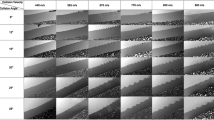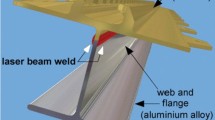Abstract
Heat sink assemblies consisting of an A6061-T6 aluminum alloy fin and a C1100 copper base are prepared by T-joint welding using a near continuous-wave fiber laser system. The effects of the welding parameters on the tensile strength and heating rate of the heat sink assembly are investigated and compared. It is shown that the maximum tensile strength and heating rate are obtained using a laser power of 220 W, a pulse width of 8 ms, a welding speed of 2 mm/s, and an incident angle of 60°. The thermal conductivity of the heat sink prepared using the optimal welding parameters is shown to be in good agreement with the ANSYS Fluent simulation results obtained under the assumption of an ideal, defect-free joint between the copper base and aluminum fin. The tensile strength and heating rate using the optimal welding parameters are 24.31 MPa and 41.2 °C/102 S, respectively. The optical microscopy (OM) images show that the thickness of the intermetallic compound (IMC) layer formed at the interface between the aluminum fin and the copper base varies with the welding parameters and has a value of approximately 6 µm under the optimal welding conditions. The energy dispersive spectrometry (EDS) results and X-ray diffraction (XRD) analysis results reveal that the welding bead consists mainly of Cu, Al, and Al2Cu phases.
















Similar content being viewed by others
Data availability
All data generated or analyzed during this study are included in the present article.
References
Shi Y, Wu S, Liao H, Wang X (2020) Microstructure and mechanical properties of CLF-1/316 L steel dissimilar joints welded with fiber laser welding. J Manuf Process 54:318–327
Cao X, Wallace W, Poon C, Immarigeon JP (2003) Research and progress in laser welding of wrought aluminum alloys. I. Laser Welding Processes. Mater Manuf Process 18(1):1–22
Mazumder WMSJ (2010) Laser material processing. Springer, London Dordrecht Heidelberg New York
H.H.T. Graf, Laser In der Fertigung, Vieweg+Teubner | GWV Fachverlage GmbH, Wiesbaden 2009
Tariq A, Altaf K, Ahmad SW, Hussain G, Ratlamwala TAH (2021) Comparative numerical and experimental analysis of thermal and hydraulic performance of improved plate fin heat sinks. Appl Therm Eng 182:115949
Abbas A, Wang CC (2020) Augmentation of natural convection heat sink via using displacement design. Int J Heat Mass Transf 154:119757
Ansari D, Jeong JH (2020) A novel composite pinfin heat sink for hotspot mitigation. Int J Heat Mass Transf 156:119843
Di C, Huang S, Yu X, Xu L, Jiao K (2021) Effect of cutting tool materials on temperature field of cutting AF1410 high strength steel. J Ordnance Equip Eng 6:243–250
Zhou X, Zhang G, Shi Y, Zhu M, Yang F (2017) Microstructures and mechanical behavior of aluminum-copper lap joints. Mater Sci Eng, A 705:105–113
Zhang J, Huang T, Mironov S, Wang D, Zhang Q, Wu Q, Xu J, Xiao R (2021) Laser pressure welding of copper. Opt Laser Technol 134:106645
Weigl M, Schmidt M (2010) Influence of the feed rate and the lateral beam displacement on the joining quality of laser-welded copper-stainless steel connections. Phys Procedia 5:53–59
Solchenbach T, Plapper P (2013) Mechanical characteristics of laser braze-welded aluminium–copper connections. Opt Laser Technol 54:249–256
Kah P, Vimalraj C, Martikainen J, Suoranta R (2015) Factors influencing Al-Cu weld properties by intermetallic compound formation. Int J Mech Mater Eng 10:10
Yan S, Shi Y (2019) Influence of laser power on microstructure and mechanical property of laser-welded Al/Cu dissimilar lap joints. J Manuf Process 45:312–321
Xia H, Tan C, Tian R, Meng S, Li L, Ma N (2020) Influence of shielding gas on microstructure and mechanical properties of laser welded–brazed Al/steel lapped joint. J Manuf Process 54:347–358
Choudhury T, Ghorai A, Medhi T, Acharya U, Roy BS, Saha SC (2021) Study of microstructure and mechanical properties in friction stir welded aluminum copper lap joint. Materials Today: Proceedings 46:9474–9479
Yan S, Li Z, Song L, Zhang Y, Wei S (2023) Research and development status of laser micro-welding of aluminum-copper dissimilar metals: a review. Opt Lasers Eng 161:107312
Hansen KS, Kristiansen M, Olsen FO (2014) Beam shaping to control of weldpool size in width and depth. Phys Procedia 56:467–476
Rasch M, Roider C, Kohl S, Strauß J, Maurer N, Nagulin KY, Schmidt M (2019) Shaped laser beam profiles for heat conduction welding of aluminium-copper alloys. Opt Lasers Eng 115:179–189
Geng Y, Akbari M, Karimipour A, Karimi A, Soleimani A, Afrand M (2019) Effects of the laser parameters on the mechanical properties and microstructure of weld joint in dissimilar pulsed laser welding of AISI 304 and AISI 420. Infrared Phys Technol 103:103081
Li Z, Rostam K, Panjehpour A, Akbari M, Karimipour A, Rostami S (2020) Experimental and numerical study of temperature field and molten pool dimensions in dissimilar thickness laser welding of Ti6Al4V alloy. J Manuf Process 49:438–446
Hu B, Richardson IM (2006) Mechanism and possible solution for transverse solidification cracking in laser welding of high strength aluminium alloys. Mater Sci Eng, A 429(1–2):287–294
Jia Z, Zhang P, Yu Z, Shi H, Liu H, Wu D, Ye X, Wang F, Tian Y (2021) Effect of pulse shaping on solidification process and crack in 5083 aluminum alloy by pulsed laser welding. Opt Laser Technol 134:106608
Yang ZB, Tao W, Li LQ, Chen YB, Li FZ, Zhang YL (2012) Double-sided laser beam welded T-joints for aluminum aircraft fuselage panels: process, microstructure, and mechanical properties. Mater Des 33:652–658
Dimatteo V, Ascari A, Liverani E, Fortunato A (2022) Experimental investigation on the effect of spot diameter on continuous-wave laser welding of copper and aluminum thin sheets for battery manufacturing. Opt Laser Technol 145:107495
Sun T, Franciosa P, Ceglarek D (2021) Effect of focal position offset on joint integrity of AA1050 battery busbar assembly during remote laser welding. J Market Res 14:2715–2726
Ahn J, Chen L, He E, Dear JP, Davies CM (2018) Optimisation of process parameters and weld shape of high power Yb-fibre laser welded 2024–T3 aluminium alloy. J Manuf Process 34:70–85
Quintino L, Costa A, Miranda R, Yapp D, Kumar V, Kong CJ (2007) Welding with high power fiber lasers – A preliminary study. Mater Des 28(4):1231–1237
Katayama S (2018) Understanding and improving process control in pulsed and continuous wave laser welding. Adv Laser Mater Process pp 153–183
Lerra F, Ascari A, Fortunato A (2019) The influence of laser pulse shape and separation distance on dissimilar welding of Al and Cu films. J Manuf Process 45:331–339
Pellone L, Inamke G, Hong K-M, Shin YC (2019) Effects of interface gap and shielding gas on the quality of alloy AA6061 fiber laser lap weldings. J Mater Process Technol 268:201–212
Beiranvand ZM, Ghaini FM, Naffakh-moosavy H, Sheikhi M, Torkamany MJ (2018) Magnesium loss in Nd:YAG pulsed laser welding of aluminum alloys. Metall and Mater Trans B 49(5):2896–2905
Çam G, İpekoğlu G (2016) Recent developments in joining of aluminum alloys. Int J Adv Manuf Technol 91(5–8):1851–1866
Bergmann JP, Bielenin M, Stambke M, Feustel T, Witzendorff PV, Hermsdorf J (2013) Effects of diode laser superposition on pulsed laser welding of aluminum. Physics Procedia 41:180–189
Dimatteo V, Ascari A, Fortunato A (2019) Continuous laser welding with spatial beam oscillation of dissimilar thin sheet materials (Al-Cu and Cu-Al): process optimization and characterization. J Manuf Process 44:158–165
Meco S, Ganguly S, Williams S, McPherson N (2019) Design of laser welding applied to T joints between steel and aluminium. J Mater Process Technol 268:132–139
Hou W, Shen Z, Huda N, Oheil M, Shen Y, Jahed H, Gerlich AP (2021) Enhancing metallurgical and mechanical properties of friction stir butt welded joints of Al–Cu via cold sprayed Ni interlayer. Mater Sci Eng: A 809:140992
Jimenez-Mena N, Jacques PJ, Ding L, Gauquelin N, Schryvers D, Idrissi H, Delannay F, Simar A (2019) Enhancement of toughness of Al-to-steel friction melt bonded welds via metallic interlayers. Mater Sci Eng, A 740–741:274–284
Funding
The authors received financial support provided by the Ministry of Science and Technology of Taiwan, ROC, under Project No. MOST 110–2221-E-020–011.
Author information
Authors and Affiliations
Contributions
CLC: resources, review, and visualization. YHC: investigation, formal analysis, data collection, visualization, and writing. HKL: writing, review, and funding acquisition.
Corresponding author
Ethics declarations
Ethics approval
Not applicable.
Consent to participate
Not applicable.
Consent for publication
Not applicable.
Competing interests
The authors declare no competing interests.
Additional information
Publisher's Note
Springer Nature remains neutral with regard to jurisdictional claims in published maps and institutional affiliations.
Rights and permissions
Springer Nature or its licensor (e.g. a society or other partner) holds exclusive rights to this article under a publishing agreement with the author(s) or other rightsholder(s); author self-archiving of the accepted manuscript version of this article is solely governed by the terms of such publishing agreement and applicable law.
About this article
Cite this article
Chang, CL., Cheng, YH. & Lin, HK. Optimization and characterization of T-joint laser welds for aluminum fin heat sink with copper base. Int J Adv Manuf Technol 124, 2323–2333 (2023). https://doi.org/10.1007/s00170-022-10652-y
Received:
Accepted:
Published:
Issue Date:
DOI: https://doi.org/10.1007/s00170-022-10652-y




